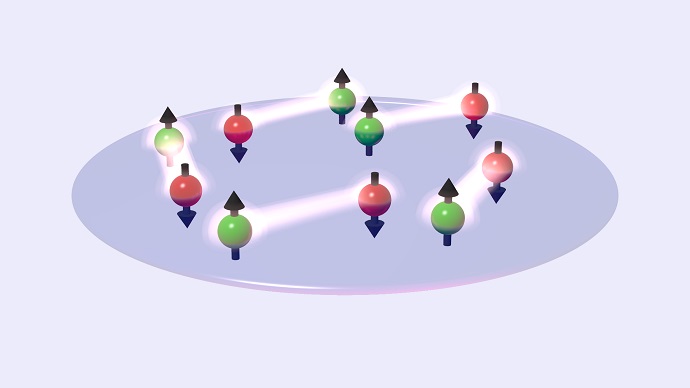28 January 2016
In a laboratory experiment, physicists at the Center for Quantum Dynamics of Heidelberg University have succeeded in determining the equation of state for an atomic gas, which can be used to precisely describe the thermodynamic properties of this physical system. According to Associate professor Dr. Tilman Enss and Prof. Dr. Selim Jochim, the equation lays the foundation for further experiments using ultracold atoms to better understand the mechanisms of superconductivity, i.e., the lossless conduction of electricity. The results of their research were published in the journal “Physical Review Letters”.
“Everyone knows how air becomes thinner as you climb a mountain. In physics this effect is described by an equation of state, which in this instance determines how the density of air changes in relation to the distance from the Earth,” explains Dr. Enss of the Institute for Theoretical Physics. “The same principle applies in many areas of physics – from the distribution of matter in the structure of stars to atomic gases, which we were recently able to manufacture in the laboratory,” says Prof. Jochim, a researcher at the Institute for Physics. At the Center for Quantum Dynamics, the researchers have combined Dr. Enss’ theoretical calculations with the findings from Prof. Jochim’s experiments. Their investigation focused on an atomic gas cooled to a temperature near absolute zero.
Physicists find ultracold atomic gases so interesting because the quantum physical effects are clearly evident at extremely low temperatures. In a certain type of particle – the fermion – two atoms can never assume the same state or occupy the same space. “The fermions exert pressure on similar types of particles and push them aside so that the density in an atomic cloud can never become too great,” explains Prof. Jochim, whose experimental working group observed this effect using lithium atoms. The pressure between the fermions causes the atomic cloud to thin and spread out.
Researchers in theoretical physics have long been interested in how the density of gas changes when fermions also attract. This counteracts the pressure of the fermions and brings the particles closer together. “If there is sufficient attraction between two fermions, they form a pair. According to the laws of quantum physics, these types of molecules can get closer together than the original fermions. Exactly how this happens in particles that move in a single plane is currently an important question,” explains Dr. Enss. The atomic gases are of great interest for research because they have many universal properties that are found in completely different physical situations. The equation of state of an atomic gas, for example, can be used to draw conclusions about the structure of certain stars.
Ultracold atoms are especially good in experiments for measuring how the equation of state relates to particle attraction. Practically any strength of attraction can be artificially created in ultracold atoms. Prof. Jochim and his research group observed that a strong attraction in the centre of the atomic cloud formed a denser nucleus. Theoretical physicists Dr. Enss and Dr. Igor Boettcher have now reconstructed the equation of state by analysing the experimental data, thereby confirming their own theoretical predictions. The researchers are particularly interested in atoms that move in one plane. The atomic gas then exhibits a similarity to layered materials that are superconducting even at a relatively high temperature. According to the Heidelberg researchers, the equation of state determined can now be used as a basis for future experiments to better understand the mechanisms of high-temperature superconductivity.
For their article published in the “Physical Review Letters”, the Heidelberg researchers received the “Editors’ Suggestion” distinction. It also was highlighted in a “Viewpoint” in the magazine “Physics”.
ORIGINAL PUBLICATION
I. Boettcher, L. Bayha, D. Kedar, P. A. Murthy, M. Neidig, M. G. Ries, A. N. Wenz, G. Zürn, S. Jochim, and T. Enss: Equation of state of ultracold fermions in the 2D BEC-BCS crossover region, Physical Review Letters (published online on 27 November 2016), doi:10.1103/ PhysRevLett.116.045303















